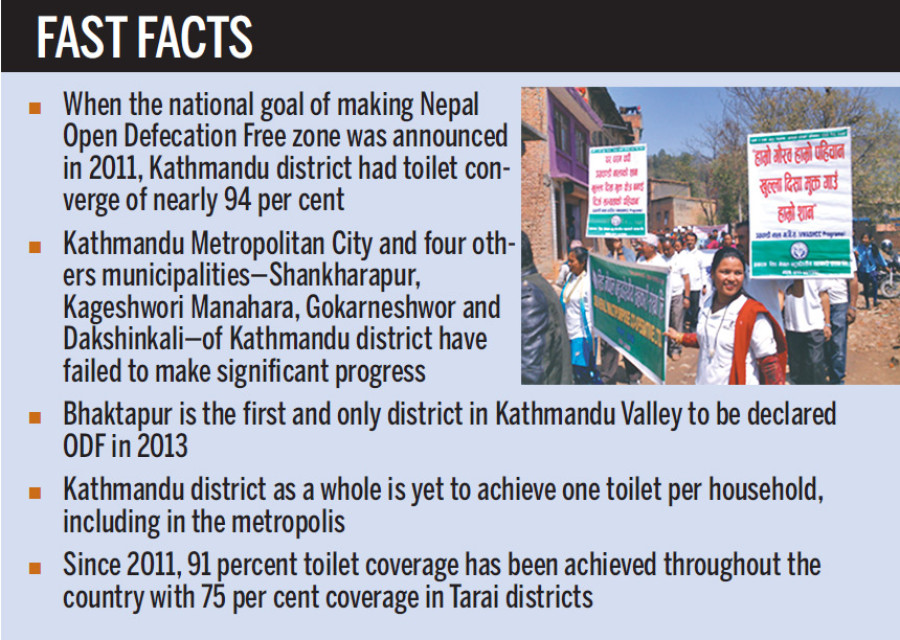Valley
Capital trails in open defecation free mission
Kathmandu district, the Capital city with one metropolis and 10 municipalities, has made slow progress when it comes to achieving the target of Open Defecation Free (ODF) zone.
Chandan Kumar Mandal
Kathmandu district, the Capital city with one metropolis and 10 municipalities, has made slow progress when it comes to achieving the target of Open Defecation Free (ODF) zone.
A total of 38 districts have already been declared ODF zones and other 13 are awaiting official declaration.
But four municipalities and the metropolis, Kathmandu Metropolitan City (KMC), of Kathmandu district are yet to get the status, even as the country nears the deadline for the national goal of achieving 100 percent toilet coverage by 2017.
The capital city Kathmandu and four others municipalities—Shankharapur, Kageshwori Manahara, Gokarneshwor and Dakshinkali—are among the places in Kathmandu district that have failed to make progress. The district has 10 municipalities and one metropolis.
In 2011, when the government and political parties came together to promote
the ODF campaign throughout the nation with an aim to make Nepal an ODF country by 2017, Kathmandu district already had toilet converge of nearly 94 per cent.
But in the last six years, achieving the remaining six-percent target has been an uphill task.
Pravin Pyakurel, an information officer at the District Coordination Committee Office Kathmandu, concedes that the district is running behind.
“We know we are running late. It seems as if we were waiting for the last phase to achieve the target,” said Pyakurel. Around 200 households are yet to build toilets in Gokarneshwor Municipality.
The number is high in other two newly declared municipalities—Shankharapur and Dakshinkali.
According to Pyakurel, dismal progress in Sundarijal and Baluwa has affected overall performance of Gokarneshwor Municipality.
Kathmandu district as a whole is yet to achieve one toilet per household including in the metropolis, said Annapurna Baral, an engineer at the Regional Monitoring and Supervision Office Kathmandu under the Department of Water Supply and Sewerage (DWSS).
“Households in rural settlements of the districts are yet build toilets,” said Baral, adding, “Even the Kathmandu Metropolitan City has not been able to achieve one toilet per household.”
Government authorities blame the Gorkha Earthquake.
“Many houses were damaged during the earthquake and along with them toilets too collapsed. Also, availability of open spaces in village areas makes open defecation possible,” said Baral.
The number of households without toilets had once rather increased after the earthquake, said Pyakurel, adding the target will be achieved in the next three months due to ongoing regular interventions by concerned authorities.
Overall the country has performed well on Total Behaviour Change (TBC) with ODF. Nepal surpassed the minimum 53 percent toilet coverage by 2015 to meet the sanitation Millennium Development Goal (MDG).
In order to make Nepal ODF by 2017, a National Sanitation and Hygiene Master Plan (2011-2017) was adopted, which aimed to achieve 100 per cent TBC by achieving open defecation free status, universal toilet coverage along with 11 other WASH (water, sanitation and hygiene ) related indicators in all 75 districts.
The master plan also promoted hygiene behaviours at household level and institutional sanitation.
Nepal has made a good stride in achieving ODF targets, says Bhim Prasad Upadhyaya, secretary at the Ministry of Water Supply and Sanitation (MoWSS). Since 2011, 91 percent toilet coverage has been achieved throughout the country with 75 per cent coverage in Tarai districts.
He, however, agrees that achieving total behavioural change and zero open defecation in urban areas like Kathmandu is difficult.
“Urban slums with no toilets, less number of public toilets and influx of thousands of people to the city like Kathmandu contributes to open defecation,” said Upadhyaya.
According to the master plan, the goal of total sanitation would be reached in two phases: achieving ODF first and then sustaining total sanitised post-ODF situation, which is a major challenge.
Upadhyaya also admits there has been leakage in maintaining the achieved ODF status in some districts.
“This campaign is related to total behaviour change, which is often not possible,” says Upadhyay, “Lack of awareness, scarcity of water, poverty and other factors are challenges in maintaining total sanitised post-ODF scene.”
Post-ODF declaration monitoring and continuous intervention by communities have helped in supporting ODF campaigns, added Upadhyaya.
KMC has been prioritising construction of new public toilets for a long time, but no tangible results have been seen except identifying locations for building such public conveniences.
Bhaktapur is the first and only district in Kathmandu Valley to be declared ODF in 2013, whereas Kathmandu and Lalitpur are still struggling to get that status.




 9.12°C Kathmandu
9.12°C Kathmandu








%20(1).jpg&w=300&height=200)

